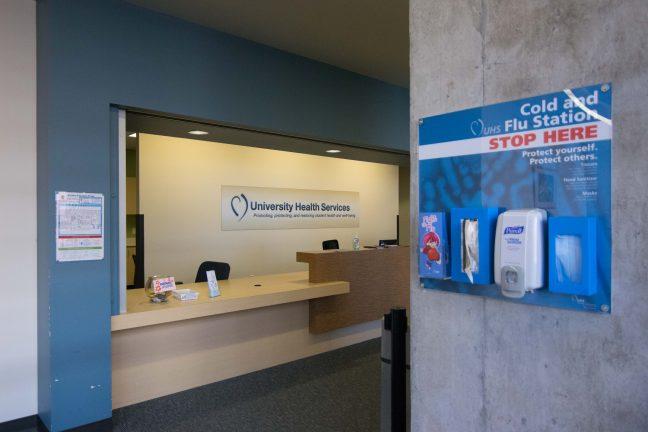Researchers at the University of Wisconsin’s Dave O’Connor Laboratory and The Friedrich Laboratory are working to develop a new, less invasive COVID-19 test that can return results much quicker than the traditional tests used nationwide.
Traditional tests utilized a swab deposited into the patient’s nasal passage where it eventually reaches the throat. The swab remains there for several seconds to collect the sample. The new test requires the patient to provide a saliva sample that is deposited into a test tube, collecting usable testing material without the need for a nasal swab.
Professor of Pathobiological Sciences for the UW School of Veterinary Medicine, Thomas Friedrich, said he and colleague David O’Connor, started developing the test in late February and early March. Friedrich and O’Connor started to think of alternative ways to test for the virus as a response to the supply shortages of materials used in traditional tests.
Friedrich said conventional tests use a process called polymerase chain reaction. This method of testing requires very specialized equipment that can normally only be found in certain labs, which means samples have to be sent to these labs to be properly analyzed. Friedrich said this, along with shortages in materials needed to conduct PCR tests, can contribute to the long wait times to get results back.
Wastewater samples from sewage treatment plants used to test for COVID-19
According to Friedrich, their test uses a process related to PCR called loop-mediated isothermal amplification. LAMP-based testing uses much less specialized equipment to detect the viruses in patients. Friedrich said laboratories can even be set up directly at testing sites.
“We think LAMP will make it possible to bring testing to schools or workplaces, and importantly, to communities that lack strong health infrastructure,” Friedrich said.
Senior Scientist in the UW Department of Pathology and Laboratory Medicine, Dawn Dudley, said the LAMP was developed 20 years ago as a cost-effective alternative to amplifying DNA. The LAMP method is used to detect many pathogens like malaria, tuberculosis, influenza, HIV and zika.
Dudley said the test works by first heating the sample to inactivate potential viruses. The sample then is diluted and added to the RT-LAMP reaction where the virus breaks open, releasing its genome. Dudley added the DNA is replicated using special primers which form extended strands of DNA. This process releases ions which change the reactions pH. Dudley said indicators will change the color of the solution accordingly, showing if the sample is positive or negative.
Friedrich said LAMP is less sensitive than PCR, meaning it can not detect very low levels of the virus.
Coronavirus pandemic disrupts UW’s swine program, leads to service partnership
“But we think this is okay because our approach focuses on catching people who have high, contagious amounts of virus and isolating them,” Friedrich said. “LAMP’s other strengths make it a good solution for situations where you want to do repeated testing with fast turnaround.”
Friedrich said the LAMP method’s fast turnaround is an important tool to help prevent the spread of COVID-19. According to Friedrich, half of SARS-CoV-2 transmission occurs before the onset of symptoms.
The ability to get rapid results back to a patient so they can quarantine themselves before they spread the virus is crucial.
The goal is to be able to test people who show no symptoms twice per week. Friechrich said their studies are looking into how they can accomplish this goal.

According to Dudley, the frequency is important to catch people at schools or workplace before they widely transmit the virus.
“A test is a snapshot in time, and people can be negative on one day and one day later become positive enough for detection,” Dudley said. “People often need to be infected for several days before there is enough virus to detect.”
Student’s experience prompts UHS to examine police hospital transport process
According to Dudley, right now the test is not considered diagnostic. This means they cannot say whether individuals have COVID-19 or not. The test is considered research and can return results that individuals could be infected and may need a diagnostic test.
Friedrich said researchers are frustrated from the lack of a coordinated response from the Food and Drug Administration. Getting tests approved for widespread use can be a long process of proving the tests are safe and accurate. The National Health Institutes’ Rapid Acceleration of Diagnostics program has helped fund the project and is working on getting government approvals.
Along with COVID-19 testing research, University Health Services is planning on increasing their testing capacity this fall.
UW-Madison announces formal reopening plan for fall semester
Health Communications Specialist for UHS, Kelsey Anderson, said there will be four testing sites in total. The Ogg Hall and Holt testing sites will be reserved for students in university housing for required scheduled testing. The site at Henry Mall and the Fluno Center will be open to all UW employees and students.
Anderson said testing is open to all who wish to be tested but is encouraged for people of certain groups. These groups include those who have symptoms for COVID-19, those who were in contact with someone who’s tested positive for COVID-19 and those whose job puts them at high risk of coming in contact with COVID-19.
Anderson said the testing is to occur for as long as necessary. For now test results are expected to be back within 72 hours. Once the Wisconsin Veterinary Diagnostic Lab begins processing tests, people can expect results within 24 hours. The testing sites have a capacity of 6,000 tests per week.
According to Anderson, UHS is implementing contract tracing in addition to opening test sites.
“We established a contact tracing process earlier this summer and hired new employees as part of this effort,” Anderson said. “Contact tracers work to identify anyone who may be at increased risk of exposure and will notify those individuals when that is the case.”


















